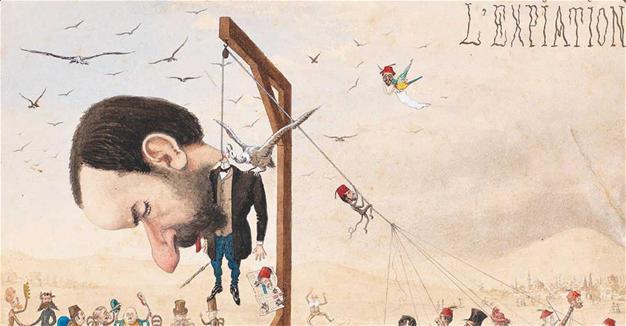Ottoman minister’s caricatures exhibited for first time in Istanbul
ISTANBUL

The caricature album of the late 19th century Ottoman bureaucrat and Minister of Foreign Affairs, Yusuf Franko Kusa Bey, who was also a governor general and a playful caricaturist, is being exhibited for the first time at the Koç University Research Center for Anatolian Civilizations (ANAMED).
“The Characters of Yusuf Franko: An Ottoman Bureaucrat’s Caricatures” displays the caricatures that Yusuf Franko compiled in an album from 1884 to 1896 that interact with the European caricature tradition.
The exhibition is curated by Bahattin Öztuncay and designed by Yeşim Demir Pröhl. Mehmet Kentel is the consultant and the scripter of the exhibition.
Speaking to state-run Anadolu Agency, Kentel said the exhibition in Istanbul was made up of six sections.
“The first is the family section. One can see the story of Yusuf Franko and his family. It is the section where we open up the connections between Lebanon and Beyoğlu. The second section is the caricature section. We address issues like how the art of caricatures developed in Europe and how they came to the Ottoman Empire. The third section is a kind of entrance to Beyoğlu, addressing why his caricatures came together in Beyoğlu and what was happening in Beyoğlu in the 19th century. The fourth section explains how Beyoğlu turned into a diplomatic venue, and brings together families drawn by Yusuf Franko,” Kentel said.
The fifth section is about Beyoğlu becoming a culture and arts center, while the last section is about poorer classes who were excluded from Beyoğlu and had to leave as it developed, he added.
One of the most striking works in the exhibition is the “social network map,” featuring relations between Franko’s characters, their positions and collaborations.
Kentel said they had scanned the Prime Ministry Ottoman archives as well as the Ottoman Bank archives, city plans, city indexes and personal archives at Salt Galata for the exhibition.
“The Ömer Koç Collection was also one of the most important resources for us,” he added.
Portraits of wealthy society members Through the exhibited caricatures, the visitors will meet satirically charged portraits of wealthy capitalists, members of high society, Ottoman soldiers, Levantines, artists, and diplomats of the late 19th century.
The caricatures offer the spectators the opportunity to observe colorful social networks, especially those of the Beyoğlu/Pera quarter, which Yusuf Franko himself belonged to, and the global locals of Istanbul.
By following the characters in their caricatures, the exhibition emphasizes how the Galata–Beyoğlu axis became a financial and diplomatic center as well as a frequent destination of international culture and arts.
The exhibition, which mainly tries to evaluate the works of Yusuf Franko from the perspective of space and social networks, touches on the significant places of the period such as the Naum Theater and it also serves as a reminder of those locales that no longer exist.
The exhibition also deals with the prominence of the Franko Kusa family within the Ottoman Empire, and with the history of caricatures in Europe.
The exhibition also narrates the long trek of the album through various countries and the tale of its return to Beyoğlu.
In addition to the album and caricatures of Yusuf Franko Kusa, related photographs, documents and publications from various collections, particularly from the Ömer M. Koç Collection, are featured in the exhibition.
Concurrently with the opening of the exhibition, a special two-volume publication featuring a book of research articles, “Youssouf Bey: The Charged Portraits of Fin-de-Siècle Pera,” and a facsimile edition of Yusuf Franko Kusa’s album “Types et Charges” is available.
The exhibition can be viewed through June 1.
 The caricature album of the late 19th century Ottoman bureaucrat and Minister of Foreign Affairs, Yusuf Franko Kusa Bey, who was also a governor general and a playful caricaturist, is being exhibited for the first time at the Koç University Research Center for Anatolian Civilizations (ANAMED).
The caricature album of the late 19th century Ottoman bureaucrat and Minister of Foreign Affairs, Yusuf Franko Kusa Bey, who was also a governor general and a playful caricaturist, is being exhibited for the first time at the Koç University Research Center for Anatolian Civilizations (ANAMED).